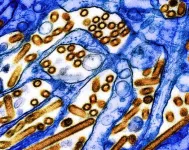(Press-News.org) While H5N1 avian influenza virus taken from infected cow’s milk makes mice and ferrets sick when dripped into their noses, airborne transmission of the virus between ferrets — a common model for human transmission — appears to be limited.
These and other new findings about the strain of H5N1 circulating among North American dairy cattle this year come from a set of laboratory experiments led by University of Wisconsin–Madison researchers, reported today in the journal Nature. Together, they suggest that exposure to raw milk infected with the currently circulating virus poses a real risk of infecting humans, but that the virus may not spread very far or quickly to others.
"This relatively low risk is good news, since it means the virus is unlikely to easily infect others who aren’t exposed to raw infected milk," says Yoshihiro Kawaoka, a UW–Madison professor of pathobiological sciences who led the study alongside Keith Poulsen, director of the Wisconsin Veterinary Diagnostic Laboratory, and with collaborators at Texas A&M University, Japan’s University of Shizuoka and elsewhere.
Kawaoka cautioned, however, that the findings represent the behavior of the virus in mice and ferrets and may not account for the infection and evolution process in humans.
In their experiments, the UW–Madison team found that mice can become ill with influenza after drinking even relatively small quantities of raw milk taken from an infected cow in New Mexico.
Kawaoka and his colleagues also tested the bovine H5N1 virus's ability to spread through the air by placing ferrets infected with the virus near but out of physical contact with uninfected ferrets. Ferrets are a common model for understanding how influenza viruses might spread among humans because the small mammals exhibit respiratory symptoms similar to humans who are sick with the flu, including congestion, sneezing and fever. Efficient airborne transmission would signal a serious escalation in the virus's potential to spark a human pandemic.
None of the four exposed ferrets became ill, and no virus was recovered from them throughout the course of the study. However upon further testing, the researchers found that one exposed ferret had produced antibodies to the H5N1 virus.
"That suggests that the exposed ferret was infected, indicating some level of airborne transmissibility but not a substantial level," Kawaoka says.
Separately, the team mixed the bovine H5N1 virus with receptors — molecules the virus binds to in order to enter cells — that are typically recognized by avian or human influenza viruses. They found that bovine H5N1 bound to both types of molecules, representing one more line of evidence of its adaptability to human hosts.
While that adaptability has so far resulted in a limited number of human H5N1 cases, previous influenza viruses that caused human pandemics in 1957 and 1968 did so after developing the ability to bind to receptors bound by human influenza viruses.
Finally, the UW–Madison team found that the virus spread to the mammary glands and muscles of mice infected with H5N1 virus and that the virus spread from mothers to their pups, likely via infected milk. These findings underscore the potential risks of consuming unpasteurized milk and possibly undercooked beef derived from infected cattle if the virus spreads widely among beef cattle, according to Kawaoka.
“The H5N1 virus currently circulating in cattle has limited capacity to transmit in mammals,” he says. “But we need to monitor and contain this virus to prevent its evolution to one that transmits well in humans.”
END
Raw milk is risky, but airborne transmission of H5N1 from cow's milk is inefficient in mammals
New research suggests that exposure to raw milk infected with the currently circulating virus poses a real risk of infecting humans, but that the virus may not spread very far or quickly to others
2024-07-08
ELSE PRESS RELEASES FROM THIS DATE:
Features of H5N1 influenza viruses in dairy cows may facilitate infection, transmission in mammals
2024-07-08
WHAT:
A series of experiments with highly pathogenic H5N1 avian influenza (HPAI H5N1) viruses circulating in infected U.S. dairy cattle found that viruses derived from lactating dairy cattle induced severe disease in mice and ferrets when administered via intranasal inoculation. The virus from the H5N1-infected cows bound to both avian (bird) and human-type cellular receptors, but, importantly, did not transmit efficiently among ferrets exposed via respiratory droplets. The findings, published in Nature, suggest that bovine (cow) ...
Scientists discover how to improve vaccine responses to potentially deadly bacterium
2024-07-08
Researchers from Trinity College Dublin have taken a leap forward in understanding how we might fight back against the potentially deadly MRSA bacterium. They have shown in an animal model that targeting a key suppressive immune molecule (IL-10) during the delivery of a vaccine improves the ability of the vaccine to protect against infection.
The bacterium Staphylococcus aureus is one of the leading causes of community- and hospital-acquired bacterial infection, and is associated with over one million deaths worldwide each year. Unfortunately, antibiotics are becoming increasingly less effective against this bacterium with the antibiotic-resistant ...
Sauer receives funding for project studying tunable RF atomic magnetometer as an electrically small receiver
2024-07-08
Sauer Receives Funding For Project Studying Tunable RF Atomic Magnetometer As An Electrically Small Receiver
Karen Sauer, Professor, Physics and Astronomy, College of Science, received funding for the project: “Tunable RF Atomic Magnetometer as an Electrically Small Receiver.”
Sauer will complete work for this project in three phases.
In Phase 1, she will focus on developing and investigating novel bias-field control based on fully atom-based measurements as well as testing the performance ...
Study highlights the importance of infection prevention after CAR-T cell therapy
2024-07-08
RESEARCH SUMMARY
Study highlights the importance of infection prevention after CAR-T cell therapy
Study Title: A systematic review and meta-analysis of nonrelapse mortality after CAR T cell therapy
Publication: Nature Medicine
Dana-Farber Cancer Institute authors: David M. Cordas dos Santos, MD, Irene M. Ghobrial, MD, Jean-Baptiste Alberge, PhD
Summary: Researchers at Dana-Farber Cancer Institute, in collaboration with colleagues from Memorial Sloan Kettering Cancer Center in New York (Dr. Kai Rejeski) and the LMU Hospital in Munich, Germany (Dr. Tobias Tix), have found ...
New gold standard survey shows alarmingly high rate of sexual exploitation across the United States
2024-07-08
A revised version of the Sexual Experiences Survey – Victimization (SES-V), the gold standard measurement of sexual exploitation designed for adults over age 18, has been released in a special issue of the Journal of Sex Research.
As the first revision since 2007, the new SES-V is an interdisciplinary collaboration among experts across more than 10 U.S. universities and the Kinsey Institute, led and coordinated by Dr. Mary Koss from the University of Arizona. It adopts more inclusive language and ...
Stench of a gas giant? Nearby exoplanet reeks of rotten eggs. And that’s a good thing
2024-07-08
An exoplanet infamous for its deadly weather has been hiding another bizarre feature—it reeks of rotten eggs, according to a new Johns Hopkins University study of data from the James Webb Space Telescope.
The atmosphere of HD 189733 b, a Jupiter-sized gas giant, has trace amounts of hydrogen sulfide, a molecule that not only gives off a stench but also offers scientists new clues about how sulfur, a building block of planets, might influence the insides and atmospheres of gas worlds beyond the solar system.
The findings are published today ...
Study backs RSV vaccine safety during pregnancy
2024-07-08
Vaccinating mothers against respiratory syncytial virus (RSV) during late pregnancy to protect their newborns is not associated with an increased risk of preterm birth or other poor outcomes, according to a study by Weill Cornell Medicine and NewYork-Presbyterian investigators. Infants are particularly vulnerable to the virus which can cause a serious lower respiratory illness.
The study published in JAMA Network Open on July 8 adds real-world evidence to the existing data from clinical trials about the safety of Pfizer’s Abrysvo vaccine. The researchers found that there ...
Brigham study finds new program streamlined hospice transitions from the emergency department
2024-07-08
KEY TAKEAWAYS
After implementing a new hospice transition program, 210 out of 388 patients (54.1 percent) at Brigham and Women’s Hospital transitioned to hospice from the emergency department (ED) within 96 hours, compared to 61 of 270 patients (22.1 percent) in the control period.
Across all groups, the presence of a Medical Order for Life-Sustaining Treatment plan (MOLST), was independently associated with hospice transition.
These findings suggest that hospice transition programs can help improve use of hospice for patients presenting at the ED near the end ...
Diet quality among children
2024-07-08
About The Study: Although total dietary quality scores among U.S. children improved overall during 2005-2020, the increase remained suboptimal: lower than 5 points, a significant threshold for children in this analysis of changes in diet quality.
Corresponding Author: To contact the corresponding author, Yongjun Zhang, Ph.D., M.D., email zhangyongjun@sjtu.edu.cn.
To access the embargoed study: Visit our For The Media website at this link https://media.jamanetwork.com/
(doi:10.1001/jamapediatrics.2024.1880)
Editor’s Note: Please see the article for additional information, ...
Acceptability of hospital-at-home care and capacity for caregiver burden
2024-07-08
About The Study: Survey respondents reported substantial acceptability of hospital-at-home care, which did not vary across sociodemographics, health insurance coverage, health status, prior hospitalizations, or telehealth use. Approximately half of respondents agreed that hospital-at-home care was effective, safe, and convenient. Most indicated capacity to perform many caregiver tasks.
Corresponding Author: To contact the corresponding author, Melissa A. Frasco, Ph.D., email mfrasco@usc.edu.
To access the embargoed ...
LAST 30 PRESS RELEASES:
New mega-analysis reveals why memory declines with age
Understanding ammonia energy’s tradeoffs around the world
UTHealth Houston researchers map gene disruptions in sporadic early onset Alzheimer’s disease across key brain regions
Minimum wage increases are linked to safer pregnancies
Left in the cold: Study finds most renters shut out of energy-saving upgrades
This crystal sings back: Illinois collaboration sheds light on magnetochiral instability
Organisms in the Atacama Desert soil are remarkably diverse
Children’s Hospital Colorado research outlines first pediatric classifications for suicide risk in adolescents and kids
No thyme wasted: Harnessing the medicinal benefits of thyme extract With small doses
Fat surrounding the colon interacts with the immune system
Genetic predisposition to excess body weight and survival in women diagnosed with breast cancer
New mechanism links Epstein-Barr virus to MS
Genetic risk factor and viral infection jointly contribute to MS
When a virus releases the immune brake: New evidence on the onset of multiple sclerosis
Wyss Institute-led collaboration awarded by ARPA-H PRINT program to engineer off-the-shelf, universal, transplant-ready graft for liver failure
Research on the behavioral mechanisms of rural distributed photovoltaic development: A view of prosumer perspective
More surgical patients are on opioid use disorder medications — hospitals must modernize pain care
New study reveals strategic logic behind global patent litigation venue selection
An abnormally slow heart rate is associated with xylazine-fentanyl overdose; primarily seen in northeastern United States
The path to solar weather forecasts
Inflammation and mitochondrial dysfunction in cirrhotic cardiomyopathy: therapeutic implications
The Great Bear Rainforest nature writing retreat
Research reveals hidden diversity of E. coli driving diabetic foot infections
Breakthrough in parallel Cartesian grid generation: Dynamic partition weight strategy resolves load imbalance
ESMT Berlin study shows how startups can communicate to win over silent audiences online
Design and optimization of wide-speed double swept waverider based on curved-cone projection method
Giant Magellan Telescope names Daniel T. Jaffe as president
New parameterization method for cislunar space cataloging enhances orbital awareness in Earth-Moon system
A “nu” way to measure researcher impact
Dark matter may have begun much hotter than scientists thought
[Press-News.org] Raw milk is risky, but airborne transmission of H5N1 from cow's milk is inefficient in mammalsNew research suggests that exposure to raw milk infected with the currently circulating virus poses a real risk of infecting humans, but that the virus may not spread very far or quickly to others


